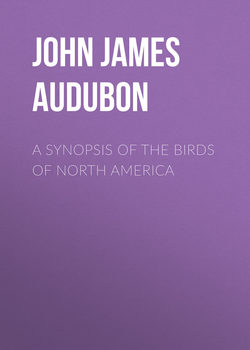Читать книгу A Synopsis of the Birds of North America - John James Audubon - Страница 19
FAMILY III. STRIGINÆ. OWLS
GENUS IV. SYRNIUM, Cuv. HOOTING-OWL
ОглавлениеBill short, stout, broad at the base; upper mandible with its dorsal outline convex to the end of the cere, then curved, the sides sloping and nearly flat, the tip compressed, decurved, acute; lower mandible small, with the dorsal line convex, the tip narrow, the edges decurved toward the end. Nostrils large, elliptical. Conch of the ear of medium size, and furnished with an anterior semicircular operculum, beset with slender feathers. Legs rather short; tarsi very short, and with the toes feathered. Claws slightly curved, long, slender, compressed, acuminate. Plumage very soft and downy; facial disks complete. Wings very large, much rounded, the outer quill with the tips of the filaments separated and recurved, as are those of the terminal portion of the next; the outer six with the inner webs sinuate. Tail broad, rounded.
35. 1. Syrnium cinereum, Linn. Great Cinereous Hooting-Owl. – Cinereous Owl
Plate CCCLI. Female.
Upper parts greyish-brown, variegated with greyish-white in irregular undulated markings; the feathers on the upper part of the head with two transverse white spots on each web; the smaller wing-coverts of a darker brown, and less mottled than the back; the outer scapulars with more white on their outer webs; primaries blackish-brown toward the end, in the rest of their extent marked with a few broad light grey oblique bands, dotted and undulated with darker; tail similarly barred; ruff-feathers white toward the end, dark brown in the centre; disks on their inner sides grey, with black tips, in the rest of their extent greyish-white, with six bars of blackish-brown very regularly disposed in a concentric manner; lower parts greyish-brown, variegated with greyish and yellowish-white; feet barred with the same.
Female, 301/2, 481/2.
From Massachusetts on the east, and Columbia River on the west, northward. Migratory.
Great Grey or Cinereous Owl, Strix cinerea, Nutt. Man. v. i. p. 128.
Cinereous Owl, Strix cinerea, Swain. & Rich. F. Bor. Amer. v. ii. p. 77.
Great Cinereous Owl, Strix cinerea, Aud. Orn. Biog. v. iv. p. 364.
36. 2. Syrnium nebulosum, Linn. Barred Hooting-Owl. Barred Owl
Plate XLVI. Male.
General colour of upper parts light reddish-brown; face and greater part of the head brownish-white; the feathers of the latter broadly marked with brown, of which a narrow band passes from the bill along the middle of the head; feathers of the back and most of the wing-coverts largely spotted with white; primary coverts, quills, and tail, barred with light brownish-red; wings and tail tipped with greyish-white; lower parts pale brownish-red, longitudinally streaked with brown, excepting the neck and upper part of the breast, which are transversely marked, the abdomen, which is yellowish-white, and the tarsal feathers, which are light reddish.
Male, 18, 40.
From Texas to Nova Scotia. Resident in the south and west. Very abundant.
Barred Owl, Strix nebulosa, Wils. Amer. Orn. v. iv. p. 61.
Strix nebulosa, Bonap. Syn. p. 38.
Barred Owl, Strix nebulosa, Nutt. Man. v. i. p. 133.
Barred Owl, Strix nebulosa, Aud. Orn. Biog. v. i. p. 242: v. v. p. 386.
